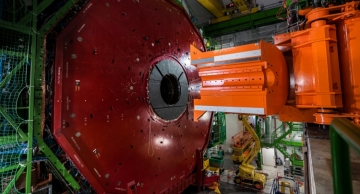Running toward the start of Run3 at the Large Hadron Collider (LHC), the CMS experiment completed one of its last and crucial steps: the big solenoid magnet has been powered on to reach the nominal magnetic field of 3.8T on March 4th 2022.
Hidden…
News
|
ikhalid |
Detector
A few months are left before the start of Run 3 at CERN. With the timely completion of all upgrades planned for Long Shutdown 2 (LS2), in the last weeks the CMS detector has been set in its closed configuration. If this sounds like an ordinary or…
|
ikhalid |
Detector
The challenge of Run3: CMS is preparing to resume its operations for the Run-3 of the Large Hadron Collider (LHC) after a 3-year long shutdown called LS2 (2019-2021). The time of LS2 was used to perform upgrades, which are regularly conducted…
|
ikhalid |
Detector
The installation of a new prototype of CMS muon chambers was completed last December. With these installations, the CMS detector is taking further steps towards the HL-LHC era at CERN.
With the future High Luminosity Large Hadron…
|
ikhalid |
Detector
During the CERN pilot beams at the end of October, for the first time CMS has reconstructed online the LHC collision data with Graphic Processing Units (GPUs).
At CMS, the High Level Trigger (HLT) is responsible for analysing in…
|
ikhalid |
Detector
As the end of Long Shutdown 2 (LS2) is getting closer, CERN along with the experiments at the Large Hadron Collider (LHC) is preparing to welcome the most awaited Run 3 next year. The CMS experiment geared up for the two weeks of CERN pilot beams in…
|
ikhalid |
Detector
The Large Hadron Collider (LHC) has been providing particle collisions at larger and larger luminosities over the years, thanks to a series of upgrades. However, the most anticipated upgrade has yet to come: the High Luminosity LHC (HL-LHC). Here…
|
losmith |
Detector
The focus of Run Coordination during Long Shutdown 2 (LS2) is to organize regular detector-commissioning periods which help to closely monitor the advance of maintenance and upgrade activities, to smooth interactions between subsystems. This ensures…
|
losmith |
Detector
After long months of preparations, the Beam Radiation, Instrumentation, and Luminosity (BRIL) group has completed the installation of three instruments dedicated to the measurement of luminosity and beam conditions: the Beam Condition Monitor “Fast…
|
fbaldass |
Detector
After more than two years with lots of delicate work the Pixel Tracker has been successfully installed at the centre of the CMS detector and it is now ready for commissioning.
The Pixel Tracker is the CMS sub-detector closest to the interaction…
|
losmith |
Detector
Reaching another major milestone of the Long shutdown 2 and performing the biggest upgrade of the experimental beam vacuum system since the first operation of CMS in 2008. After several years of complex design, manufacture and planning, the CMS…
|
losmith |
Detector
As for any other instrument, the CMS experiment needs a “quiet” environment to take data, with the lowest level of background noise. In the CMS detector, background noise is mainly due to energetic particles generated at high eta (i.e. close to the…












